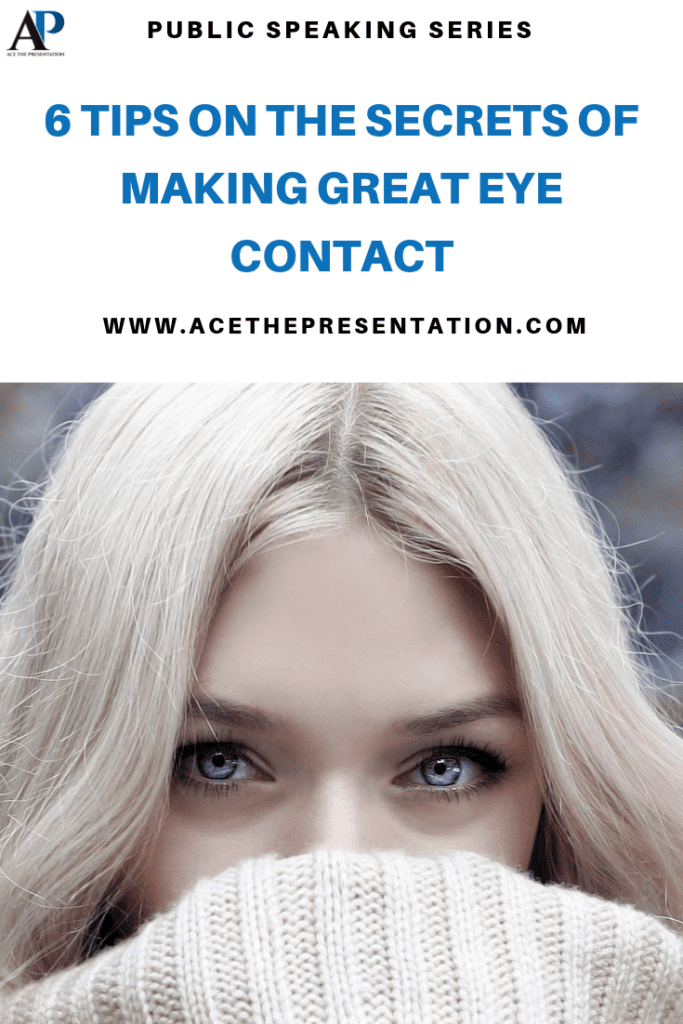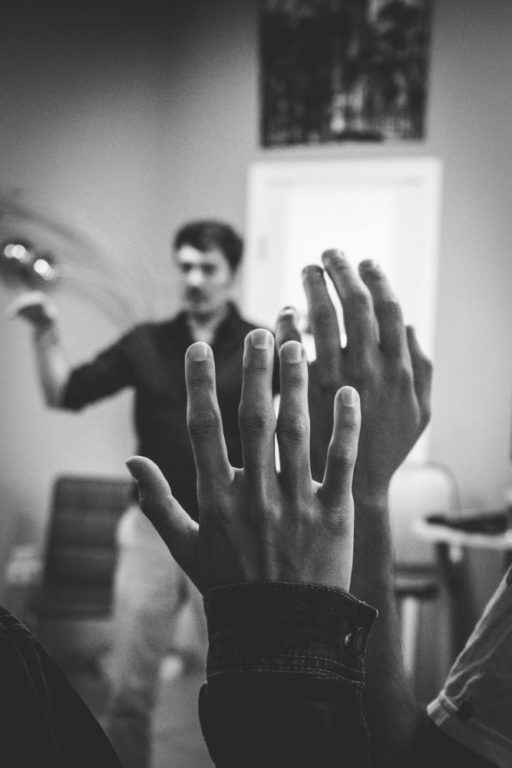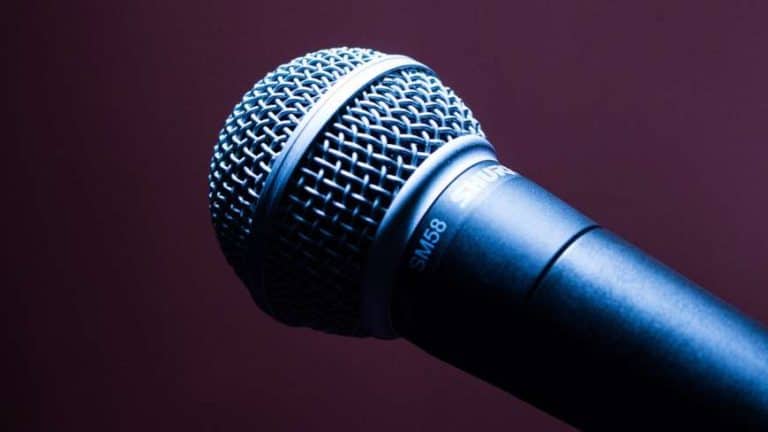6 Solid Tips about Making Eye Contact
For most people, their first time addressing a crowd can be so scary and they tend to feel nervous or Jittery. My first time facing the crowd was quite an experience for me. I got on the stage and felt like I needed the ground to open up and take me in. One of the most difficult aspects for me was looking at the crowd, making eye contact, and look confident. I could not! It always felt like there were a million eyes boring my soul.
Over the years, however, I learned that the reason I was not being able to properly convey the message I wanted was because my fear was noticed obviously and that made me a laughing stock for some, and an unreliable source of information for others. If only I could have easily found a way to improve myself in making eye contact, while speaking, and was confident about it, it would have been a different story.
Making eye contact, though tactical is a very essential key for any speaker to defeat the dominance of the crowd. Through bold eye contact in a presentation, your audience have faith in you much more than you do yourself.
The term eye contact is rather vague, it can infer to just making fleeting contact with a person and then moving on. I want you to know that this is not what I would like to discuss today, I want to discuss how you while speaking in public ensure that you are making eye contact and connecting with the audience.
Don’t just make eye contacts, make EYE CONNECTION. Eye connection means spending time with each person so that the person feels you are talking to them. Now I said eye connection not stare the person out.
You might feel you want to make a one-on-one person talk hereby making the rest of the audience disappear in your mind’s eye. But remember you don’t want to creep the person and the rest of the audience out in the process. The reality is the audience will always be there.
Eye connection has a mutual benefit to you and your audience. People in the audience will feel you have genuinely connected with them and you care about their reaction, whether or not they understand it. Also, because you are talking to people at intervals, connecting one on one with each member of the audience, they will see you as conversational and will be eager to listen to you more and be willing to be engaged.
If there is one simple thing in which you can use to enhance your impact as a presenter and convince or persuade your audience to see things and understand your point the way you do, it is meaningful and consistent eye contact with your audience. It helps you build positive rapport with your audience and helps you communicate and convey your message on a personal level.
A room full of people with different lightning, sounds and snickering can rack up your nerves but when you deliberately focus on the eyes of different members of the audience, it helps calm your nerves and speak confidently. You will also find out you are concentrating on your message.
When you look at someone for three to five seconds, you will naturally find out that your speech slows down and you are explaining better and sound more authoritative in your speech.
With sustained and focused eye contact comes authority, the audience will believe not that you know what you are saying. This can’t be compared to someone who averts his or her gaze anytime they are trying to talk to you. Unlike this, good eye connection communicates confidence and fosters a good relationship between you and your audience even if you are not an expert on your present topic.
What if I am afraid of Making Eye Contact? (My Personal Struggle)
Well, Rome wasn’t built in day. So, you shouldn’t expect to become an assertive presenter right off the bat. It takes time, practice, and willingness to improve yourself.
I was 16 years old when my mentor suddenly told me to stand up in front of dozens of people and present a topic which taught me over the previous months. I was knowledgeable about the topic, but amongst those seated in the crowd there were people who knew a lot more about that topic than I did, I was inexperienced, had no confidence, and was really worried about slipping up or biting my tongue in the process.
If I were to try and describe all the emotions I felt at that very moment, I would probably not find enough words, but the thing is looking at them in the eye was way out of my league, I had other concerns and honestly, I was really afraid to even speak in front of the crowd, let alone making eye contact.
Do you want to know what happened that day, and the next few days where my mentor insisted that I delivered speeches on several topics? I got brain freeze, stuttered, trembled, would deliver long-winded speeches with no logical sequence, but always kept asking questions to my mentor on how to improve on several aspects of speech delivery.
When it came to eye contact, which was one of the most difficult things to master, as I was really timid in my early teens, he taught me a trick. “If you cannot make eye contact with the audience, then look at their foreheads, keep looking around and cover the whole room, from right to left, left to right, up and down if need be. Make them feel like you are looking at all of them.”
Obviously, I took this advice and applied it in all subsequent speech delivery engagements that he arranged, and after about 3 months, I was now making real eye contact, enjoying sharing the little knowledge that I had acquired, and really feeling the engagement and positive feedback just from making eye contact with my audience. It’s a great feeling, and it allows you to adjust your speech, tone, pace, and so on based on the reactions that you get.
That little teen was now capable of speaking in front of others more confidently, and make meaningful eye contact with the audience and gauge the reception, interest, and satisfaction levels.
How do you improve your eye contact?
This might prove difficult to some people especially if it is your first time facing the crowd. With eye contact comes confidence, if you can build your confidence, then you can build your eye contact. Likewise, if you can start by making eye contacts with your audience, your confidence will naturally increase. Here are ways in which your eye contact or rather, eye connection can be improved.
- Listen to your audience: a lot of people had the same experience as myself the first time.
Most times all we see is a blur of faces in the audience and that tends to shake our nerves. Learn to see people, and by people, I mean individual audience members. It makes you calmer. See your audience as individual listeners and try to make connections with them personally. Ensure eye contact as you deliver all critical lines. Look from one audience member briefly to another. Let them feel you notice and connect with them.
For a start, look at one member and imagine the person is the only one in the room. It’s called shrinking the audience. For few seconds focus on just that one person and have a one on one conversation with that person, you will begin to feel less nervous, then you move on to another member. Take note, for a few seconds. Don’t stare! This always creeps the audience out. No one likes to be stared at oddly.
2. Involve everyone: the key here is to connect with as many people as possible. Though it is impractical when you are dealing with a large audience. Endeavour to cover each section of the crowd in such cases. You can choose a member from each section to connect with. Don’t follow a pattern but rather connect randomly otherwise you might look unnatural. It takes not more than five seconds to accomplish a connection. There is minimal risk if you follow this pattern and it helps you control your speaking rate.
3. Move to another person at an appropriate time: it’s impossible to start counting 5 seconds in your head while trying to give a presentation. So how do you know how long you have connected with a person. You can keep track using your sentences. Most times, by the time you finish your sentences, you find the particular audience nodding in understanding. If you are one who loves the use of long sentences, then you should make use of phrases to tab yourself and work on making your sentences shorter so it wouldn’t be difficult for the audience to understand what you are saying.
In a presentation, the presenter adds formatting in the way he or she delivers, the presenter makes use of verbal formatting. The same way a document has paragraphs and full stops is the same way a presenter should use it to time himself or herself.
Also, while doing this, don’t be systemic with it. Don’t be a lighthouse presenter who just looks right and left automatically, be random and unpredictable when making eye contact with the audience. Mix it up, be random! Always notice the reaction of your audience, once a member you are connecting with starts to nod, then you are rest assured that you are communicating well with your audience. However, be sure to highlight key points with strong eye contacts. This draws their attention closer to your presentation.
4. Avert your eyes when making someone comfortable: Amongst your audience, there will definitely be people who don’t do well with connection. Especially the shy ones. They tend to avert their eyes anytime you look at them, in this case you are making them uncomfortable. Nevertheless, this doesn’t mean you ignore them totally. You still glance at them once in a while to make them feel noticed an important. Different cultures have different norms regarding eye contact so respect them by spending less eye connection with them.
5. Meet audience members before the presentation starts: most speakers have poor eye contact especially at the beginning of their presentation and might not properly see their audience members. In cases like this, meet up with your members before the presentation starts and relate with them personally so that when you eventually start, at least you will have some of them on your side. But nevertheless, still glance randomly from one section to another or look at a member randomly.
6. Prepare for your presentation more: Most speakers tend to pause at intervals and look at the ceiling or outer space to remember their lines or a particular point and they tend to disconnect from their audience at this point. Prepare more so you will spend more energy talking than thinking.
When you are well prepared you will look less at your note and more at the audience. Likewise, when a speaker tends to concentrate on a member for the duration of the sentence he or she is trying to elaborate, there is a tendency that when you end the sentence you will want to look at your note again. This is also one of the essence of preparation. If you have to look at your book then try pausing a bit and look at the rest of your audience at the end of the sentence you make before glancing at your book again. When you lift your head again, pick another member of the audience to connect with.

CONCLUSION
There is so much more I would have liked to discuss with you about this topic. But I believe that we have laid out some of the key things you have to be aware of when it comes to making eye contact.
Not all men are equal, nor all presenters and public speakers, I would advise against trying to copy/emulate one specific speaker, instead it will prove much more productive to you if you try your best to sound natural.
Being shy or lacking the confidence to speak in front of others, does not equate to not being able to make eye contact effectively. As a matter of fact, we engage in making eye contact in our daily conversations with family and friends, and if we are to consider speaking in front of others an extension of such conversations, then we can definitely make real eye connections with our audience.
REFERENCES & FURTHER READING
Brett & Kate McKay. How to Make Eye Contact the Right Way in Life, Business, and Love. https://www.artofmanliness.com/articles/look-em-in-the-eye-part-ii-how-to-make-eye-contact-the-right-way-in-life-business-and-love/
Accessed on 04/21/2019.
Steven Aitchison. Eye contact: The most important communication tool. https://www.stevenaitchison.co.uk/6-ways-to-dramatically-improve-your-eye-contact-skills/
Accessed on 04/21/2019








